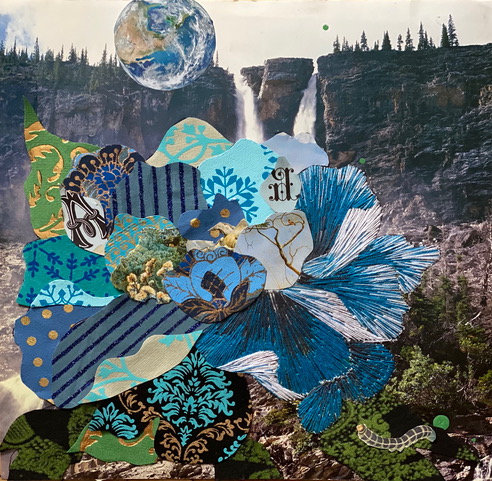Fighting Gender-Based Violence With Feminist Art Pedagogy A Co-Choreography Between Teacher, Students, and Anonymous Activists
Main Article Content
Abstract
Activist groups like No Estamos Todas (NET) leverage social media to share art memorializing feminicide victims. While analyzing NET’s social media posts for patterns in representations of victims, we noticed contributions starting in 2017 from middle schoolers in Illinois. The way these artworks focus on victims’ lives led us to explore a collaboration between NET, these students, and their teacher. Through a feminist pedagogical analysis of the project, we argue that the students engage in recognition-based gender justice. We provide guidelines for implementation and pedagogical approaches, hoping to inspire teachers to recognize students as agents of change.
Keywords: Art Teaching; Gender-Based Violence; Feminist Pedagogy
Downloads
Article Details

This work is licensed under a Creative Commons Attribution-ShareAlike 4.0 International License.
The copyright notice is CC BY SA.
This license lets others remix, tweak, and build upon your work even for commercial purposes, as long as they credit you and license their new creations under the identical terms. All new works based on yours will carry the same license. Thus any derivatives will also allow commercial use. For example, if someone translates your article into French, the French version of the article will also have to be shared under a CC BY SA license.
Funding data
-
Social Sciences and Humanities Research Council
Grant numbers 430-2018-00159
References
Acevedo, E. (2023). Gender-based violence and femicide in Mexico: Why is the law failing to protect Mexico’s women? In D. S. Peterson & D. Zhang (Eds.), International responses to gendered-based domestic violence: Gender-specific and socio-cultural approaches (pp. 39–50). Routledge.
Anttila, E. (2013). Choreographed childhoods: Patterns of embodiment in the lives of contemporary children. In G. Boldt & F. McArdle (Eds.), Young children, pedagogy and the arts: Ways of seeing (pp. 106–125). Routledge.
Blandy, D. (1999). Review of the books Art education: Issues in postmodernist pedagogy, by R. Clark & Postmodern art education: An approach to curriculum, by A. Efland, K. Freedman, & P. Stuhr. Studies in Art Education, 40(4), 373–376. https://www.jstor.org/stable/1320555
Blandy, D. (2021). Promising democracy. Studies in Art Education, 62(3), 286–290. https://doi.org/10.1080/00393541.2021.1936429
Buscemi, E. (2023). Deploying private memory in the virtual sphere: Feminist activism against gender-based violence in Mexico. International Journal of Communication (Online), 17, 2180–2199. https://go-gale-com.proxy.lib.uwaterloo.ca/ps/i.do?p=LitRC&u=uniwater&id=GALE%7CA745268302&v=2.1&it=r&sid=summon&aty=ip
Chicago, J. (1974–1979). The Dinner Party [Exhibition]. Brooklyn Museum, New York, NY, United States. https://www.brooklynmuseum.org/exhibitions/dinner_party
Congdon, K. G. (1993). Art and teaching for peace and justice. Journal of Social Theory in Art Education, 13, 13–36. https://scholarscompass.vcu.edu/jstae/vol13/iss1/4/
Doll, W. E., Jr. (1989). Foundations for a post-modern curriculum. Journal of Curriculum Studies, 21(3), 243–253. https://doi.org/10.1080/0022027890210304
Duran, A. R. (2021). Art history and human suffering: Pasts, pedagogies, and possibilities. In C. Hutt & M. Celinscak (Eds.), Artistic representations of suffering: Rights, resistance, and remembrance (pp. 59–78). Rowman & Littlefield.
Fraser, N. (2007). Feminist politics in the age of recognition: A two-dimensional approach to gender justice. Studies in Social Justice, 1(1), 23–35. https://doi.org/10.26522/ssj.v1i1.979
Fregoso, R. -L. (2023). The force of witness: Contra feminicide. Duke University Press. https://doi.org/10.1215/9781478024385
Hochtritt, L., Ploof, J., & Quinn, T. (Eds.). (2012). Art and social justice education: Culture as commons. Routledge. https://doi.org/10.4324/9780203852477
Kloppe-Santamaría, G., & Zulver, J. (2023). Beyond collateral damage: Femicides, disappearances, and new trends in gender-based violence in Mexico. Wilson Center. https://www.wilsoncenter.org/article/beyond-collateral-damage-femicides-disappearances-and-new-trends-gender-based-violence
Lather, P. (1991). Getting smart: Feminist research and pedagogy with/in the postmodern. Routledge.
Lozano, N. M. (2019). Not one more! Feminicidio on the border. Ohio State University Press.
Morbiato, C. (2017). Prácticas resistentes en el México de la desaparición forzada. REVISTA TRACE, 71, 138–165. https://doi.org/10.22134/trace.71.2017.100
Nelson, M. (2017). No Estamos Todas: feminicide presentation [PowerPoint slides].
No estamos todas. (n.d.). Posts [Facebook page]. Facebook. Retrieved March 20, 2025, from https://www.facebook.com/noestamostodas
No estamos todas [@noestamostodas]. (n.d.). Posts [Instagram profile]. Instagram. Retrieved March 20, 2025, from https://www.instagram.com/noestamostodas/
No estamos todas [@noestamostodas]. (2019, July 19). No estamos todas, nos falta Juanita 23/04/19 - Oaxaca - Tenía 14 años Ilustración por: Aylah. Estudia el séptimo grado en la [Photo]. Instagram. https://www.instagram.com/p/BztmyHaDuu1/
No estamos todas [@noestamostodas]. (2019, October 21). No estamos todas, nos falta Sofía 10/06/19 - Veracruz - Tenía 50 años Ilustración por: Ninna Falla
IG: @ninna_falla / @queenv.brand [Photo]. Instagram. https://www.instagram.com/p/B35kpkcDHVA/
No estamos todas [@noestamostodas]. (2020, December 11). No estamos todas, nos falta María
Tenía 7 años cuando fue asesinada el 10 de abril de 2020 en Veracruz [Photo]. Instagram. https://www.instagram.com/p/CIrRsnLCywn/
Nordlund, C., Speirs, P., & Stewart, M. (2010). An invitation to social change: Fifteen principles for teaching art. Art Education, 63(5), 36–43. https://doi.org/10.1080/00043125.2010.11519086
Oliver, E., & Valls, R. (2004). Violencia de género: Investigaciones sobre quiénes, por qué y cómo superarla. El Roure.
Retford, K. (2010). A death in the family: Posthumous portraiture in eighteenth-century England. Association of Art Historians, 33(1), 74–97. https://doi.org/10.1111/j.1467-8365.2009.00717.x
Salguero, M. (n.d.). Yo te nombro: El mapa de los feminicidios en México. Blogger. https://mapafeminicidios.blogspot.com/p/inicio.html
Sisson, E. (1999). Practising theory? Visual arts education and postmodern pedagogy. Circa, 89, 20–21. https://doi.org/10.2307/25563492
Téllez, G.C. (2020). No estamos todas: Ilustrando memorias. Iberoamérica social: Revista-red de estudios sociales, 8(14), 173–201. https://dialnet.unirioja.es/servlet/articulo?codigo=7500052
Trans Murder Monitoring. (2024). Will the cycle of violence ever end? TGEU’s Trans Murder Monitoring project crosses 5,000 cases. https://transrespect.org/en/trans-murder-monitoring-2024/
World Health Organization. (n.d.). Violence against women, Impact. Retrieved April 7, 2025, from https://www.who.int/health-topics/violence-against-women#tab=tab_2

